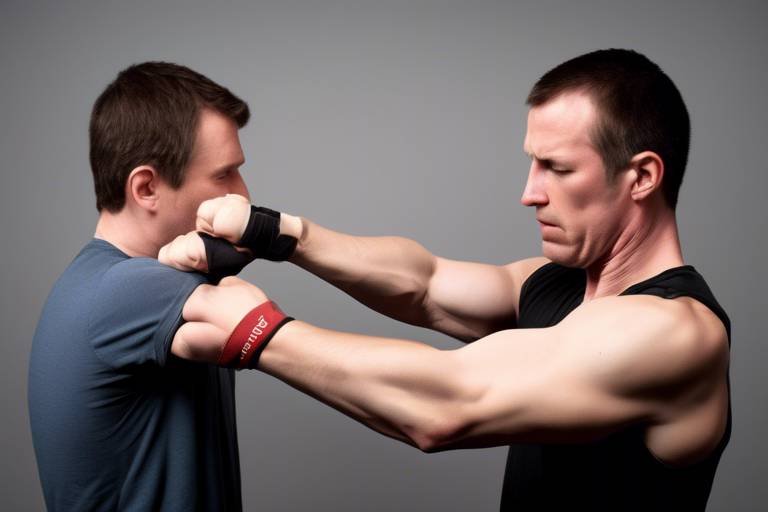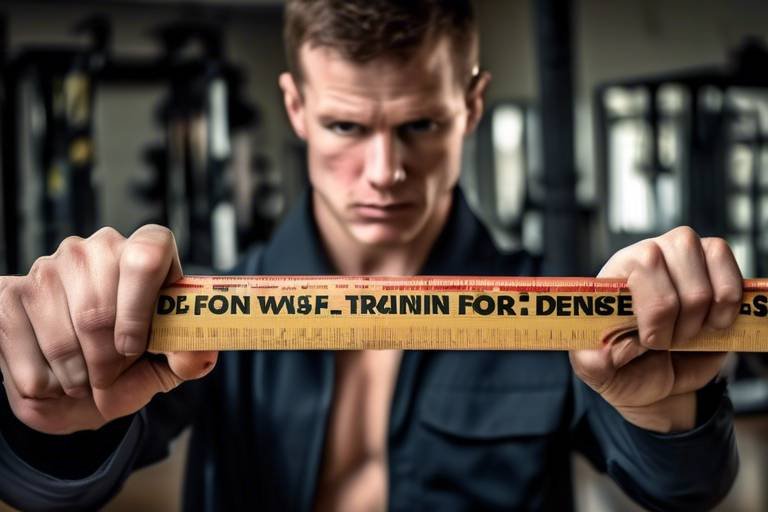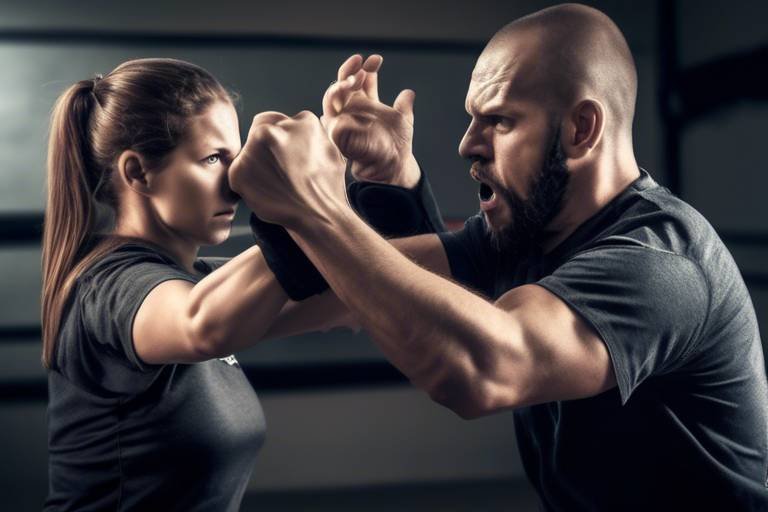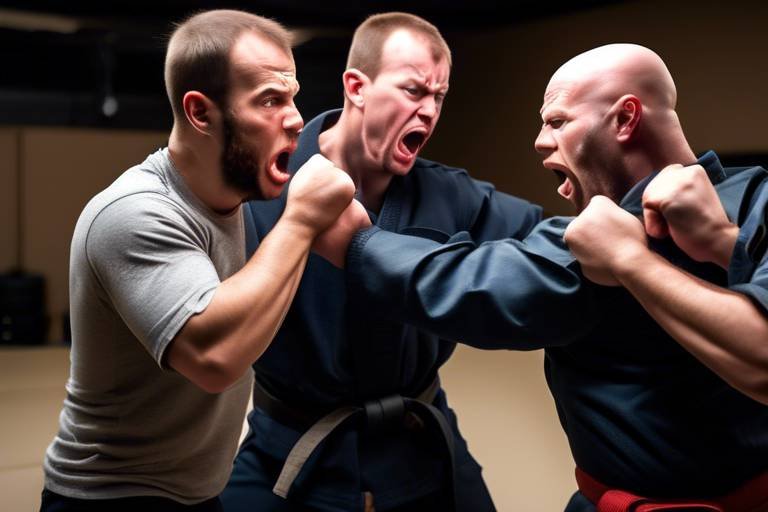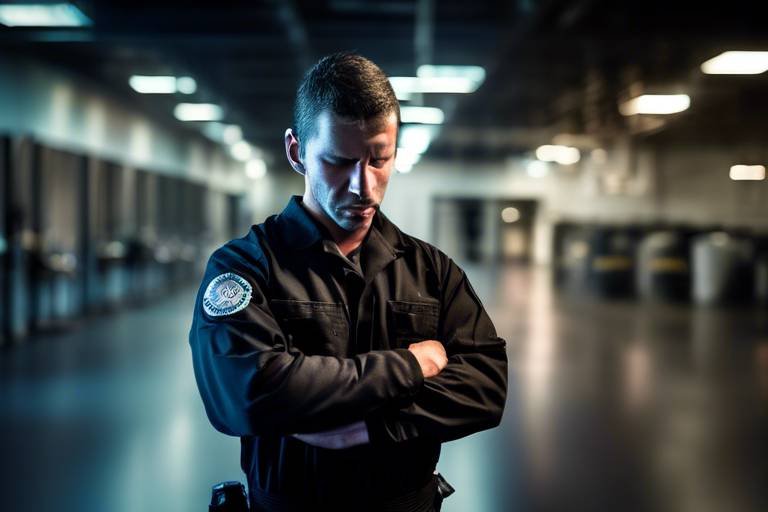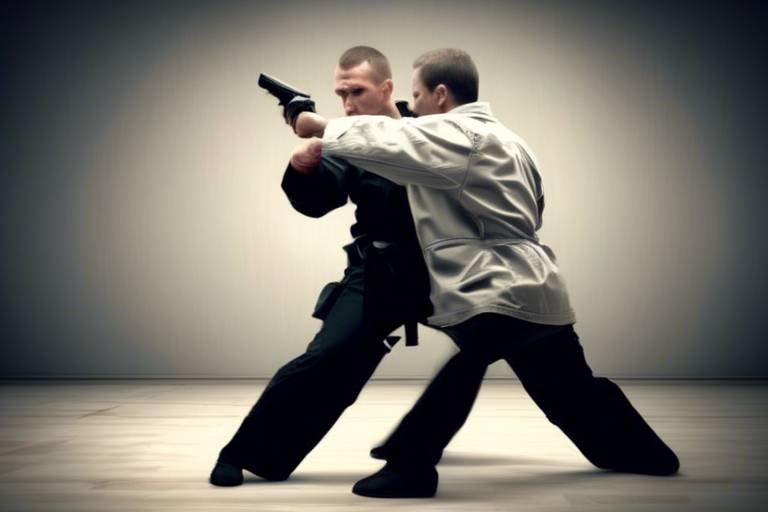Top Five Self-Defense Techniques in MMA
This article explores essential self-defense techniques used in Mixed Martial Arts (MMA), providing insights into their effectiveness and application in real-life scenarios for personal safety. In a world where the unexpected can happen at any moment, knowing how to defend oneself is not just a skill—it's a necessity. Mixed Martial Arts combines various fighting styles, ensuring that practitioners are well-rounded and prepared for a variety of confrontations. Whether you're training for competition or simply want to enhance your personal safety, understanding the top self-defense techniques in MMA can be a game-changer.
Understanding self-defense in MMA is crucial, as it equips practitioners with skills to protect themselves effectively. Self-defense training in MMA is not merely about throwing punches or executing flashy kicks; it’s about developing a mindset and skill set that can enhance your overall fighting ability. Imagine walking down the street, feeling confident and secure because you know you can handle yourself in a tough situation. This confidence stems from rigorous training that teaches you how to assess threats, react swiftly, and defend against various attacks. Moreover, self-defense training can improve your physical fitness, mental toughness, and decision-making skills under pressure. It’s like adding armor to your life—making you not just a fighter, but a survivor.
A strong foundation in stance and footwork is vital for effective self-defense. Proper positioning and movement can significantly improve your reaction times and create opportunities for counterattacks. Think of your stance as the root of a tree; if it's solid, you can weather any storm. When you're in the right position, you not only defend yourself better but also set yourself up for successful strikes. Footwork allows you to navigate the space around you, helping you evade attacks and control the distance between you and your opponent. For instance, a quick lateral movement can help you dodge a punch while simultaneously setting you up for a counter. Remember, in MMA, it’s not just about being tough; it’s about being smart and agile.
Defensive techniques are essential in MMA. These techniques are your first line of defense against an opponent’s attacks. Key strategies include:
- Blocking: Absorbing strikes with your arms and body to protect vital areas.
- Parrying: Redirecting an opponent's strike away from your body.
- Evading: Moving your body out of the way to avoid getting hit.
By mastering these techniques, you can minimize damage and maintain control during a confrontation. It’s like having an invisible shield that lets you deflect attacks while preparing for your own counter-offensive.
Blocking is a fundamental self-defense technique. It involves using your arms, hands, and body to absorb incoming strikes, protecting your head, torso, and other vital areas during an altercation. There are various blocking methods, such as high blocks, low blocks, and cross-blocks. Each serves a specific purpose and can be crucial in different situations. For example, a high block can protect your head from an overhead strike, while a low block can shield your body from a kick. Mastering these techniques is essential because they allow you to stay in the fight longer and create openings for your counterattacks. Remember, the goal is not just to withstand the attack but to turn the tables in your favor.
Evasion techniques are critical for avoiding attacks. In many cases, the best defense is to avoid getting hit altogether. Techniques such as head movement, ducking, and lateral movement can help you stay out of harm's way during a fight. For instance, a simple head movement can make a punch miss its mark, allowing you to counterattack while your opponent is off balance. Imagine a dance where you lead your partner; the more fluid your movements, the easier it is to avoid stepping on toes—or in this case, getting hit. By incorporating evasion techniques into your training, you can enhance your ability to dodge attacks and create opportunities to strike back.
Grappling techniques can be a game-changer in self-defense situations. They allow you to control and neutralize threats effectively, especially when the fight goes to the ground. Techniques such as takedowns, joint locks, and chokes can provide you with the upper hand, turning a potentially dangerous situation into one where you maintain control. Understanding how to grapple not only increases your self-defense capabilities but also boosts your confidence. You’ll feel empowered knowing you can handle yourself in close-quarters situations where striking may not be the best option.
Striking is a core component of MMA. Effective striking techniques can incapacitate an attacker quickly, making them invaluable in self-defense scenarios. Techniques like jabs, crosses, hooks, and kicks can be utilized to create distance or end a confrontation swiftly. The key to effective striking lies in precision and power; it’s not just about how hard you hit, but how accurately you can land your strikes. Think of it like a well-aimed arrow; it’s not just the strength of the bow that matters, but the skill of the archer. By honing your striking techniques, you enhance your ability to defend yourself and deter potential threats.
Physical conditioning plays a significant role in self-defense. Strength, endurance, and agility contribute to a fighter's ability to defend themselves effectively in high-pressure situations. Imagine being in a confrontation where your opponent is stronger or faster; without proper conditioning, you may find yourself at a disadvantage. Regular training not only builds your physical capabilities but also prepares you mentally for the rigors of a fight. It’s like preparing for a marathon; the more you train, the better prepared you are to face challenges when they arise.
Training for real-life scenarios is essential for practical self-defense. It’s one thing to practice techniques in a controlled environment, but applying them in realistic situations is where the magic happens. Incorporating scenario-based training into your routine can enhance your confidence and preparedness for potential threats. Whether it’s simulating an attack or practicing how to escape a hold, the more realistic your training, the better equipped you’ll be to handle real-life confrontations. It’s like rehearsing for a play; the more you practice, the more natural it becomes when it’s time to perform.
Q1: Can anyone learn self-defense techniques from MMA?
A1: Absolutely! Self-defense techniques in MMA can be learned by anyone, regardless of age or fitness level. It's all about finding the right training program that suits your needs.
Q2: How long does it take to become proficient in self-defense?
A2: Proficiency in self-defense can vary widely depending on the individual’s dedication and training frequency. With consistent practice, many people can see significant improvement within a few months.
Q3: Is MMA training safe for beginners?
A3: Yes, MMA training is designed to be safe for beginners. Most gyms offer classes tailored to different skill levels, and instructors prioritize safety while teaching techniques.
Q4: Do I need to be physically fit to start training in MMA?
A4: No, you don’t need to be fit to start. Many people begin their journey in MMA as a way to improve their fitness and learn self-defense simultaneously.

1. The Importance of Self-Defense in MMA
In the world of Mixed Martial Arts (MMA), self-defense isn't just a skill—it's a necessity. The reality is that life can throw unexpected challenges our way, and knowing how to defend oneself can make all the difference. Imagine walking down a dark alley and suddenly feeling threatened; having the right self-defense techniques can empower you to handle such situations with confidence. Self-defense training in MMA not only enhances your ability to protect yourself but also builds your overall fighting prowess.
Understanding the principles of self-defense in MMA is essential for anyone looking to engage in this sport. It’s like learning to swim before jumping into the deep end; you wouldn’t want to find yourself flailing without any skills. Self-defense training equips practitioners with the tools necessary to assess threats, react appropriately, and even de-escalate potential confrontations. This training is not just about learning to throw punches or kicks; it's about developing a mindset that prioritizes safety and awareness.
Moreover, self-defense techniques in MMA teach practitioners to remain calm under pressure. In a high-stress situation, your body goes into fight-or-flight mode. Having a solid foundation in self-defense allows you to channel that adrenaline into effective action rather than panic. It’s akin to a musician performing in front of a crowd; with practice, the nerves transform into a powerful performance. The more you train, the more instinctual your responses become, which can be crucial when every second counts.
The importance of self-defense extends beyond physical techniques—it's also about mental preparedness. Training in MMA fosters a sense of discipline and respect, not just for oneself but also for others. This respect can lead to better decision-making in potentially volatile situations. For instance, understanding when to walk away or how to defuse a situation verbally can often be more effective than physical confrontation.
In conclusion, self-defense in MMA is not merely about fighting; it’s about equipping oneself with a comprehensive set of skills that promote safety, confidence, and respect. Whether you are a seasoned fighter or a beginner, the ability to defend yourself is invaluable. It’s about creating a sense of security that transcends the training mat and permeates every aspect of your life.

2. Basic Stance and Footwork
When it comes to self-defense in Mixed Martial Arts (MMA), basic stance and footwork are the bedrock of your fighting strategy. Imagine trying to build a house without a solid foundation; it just won’t stand. Similarly, without a proper stance and agile footwork, you risk being caught off guard in a confrontation. A good stance not only prepares you to defend against incoming attacks but also sets you up for effective counters. It’s your starting point, your launchpad, if you will.
Now, let’s break down what a good stance looks like. Typically, a solid fighting stance involves keeping your feet shoulder-width apart, knees slightly bent, and weight distributed evenly. This positioning allows for quick movements in any direction, much like a cat ready to pounce. You want to feel balanced and ready to react, whether that means dodging a punch or launching your own attack.
Footwork is equally crucial. Think of it as the dance of the fight. Good footwork allows you to create distance, evade attacks, and find angles for your strikes. Here are a few essential footwork tips:
- Stay Light on Your Feet: You should be able to move quickly and fluidly. Heavy feet can make you an easy target.
- Practice Lateral Movement: Moving side to side can help you evade attacks and find openings in your opponent’s defense.
- Use Your Angles: Instead of moving straight back, angle your footwork to create better opportunities for counterattacks.
Incorporating these elements into your training will significantly enhance your self-defense capabilities. The more you practice, the more natural these movements will become, allowing you to react instinctively in high-pressure situations. Remember, in the world of MMA, every second counts. The quicker you can position yourself effectively, the better your chances of staying safe and gaining the upper hand.
To sum it up, mastering your stance and footwork is not just about looking good in the ring; it’s about survival. Whether you find yourself in a sparring match or a real-life confrontation, your ability to move fluidly and maintain a strong stance can be the difference between winning and losing. So, lace up those training shoes and get to work on your footwork—it could save your life!

3. Defensive Techniques Overview
Defensive techniques are the backbone of any self-defense strategy, especially in the dynamic world of Mixed Martial Arts (MMA). When it comes to protecting oneself, understanding how to effectively block, parry, and evade incoming attacks can make all the difference between a successful defense and a potentially dangerous situation. Imagine being in a heated altercation where every second counts; having the right defensive skills can mean the difference between walking away unscathed or facing serious injury.
To give you a clearer picture, let’s break down these essential defensive techniques:
- Blocking: This technique involves using your arms and legs to absorb or deflect incoming strikes. It’s like putting up a wall against an attack, allowing you to protect vital areas while maintaining your balance.
- Parrying: Unlike blocking, parrying is more about redirecting an opponent’s strikes. Think of it as a dance move where you gracefully move your body to change the trajectory of an incoming punch or kick, allowing you to create openings for your own counterattacks.
- Evasion: This is all about movement. By shifting your body or head out of the way of an attack, you can avoid damage entirely. Evasion techniques, such as slipping and rolling, help you maintain your position while staying safe.
These techniques not only minimize damage but also give you the opportunity to regain control of the fight. For instance, a well-timed block can set you up for a counterattack, while a successful parry can create the perfect moment to strike back. It’s crucial to practice these skills consistently, as muscle memory plays a significant role in executing them effectively under pressure.
Moreover, understanding the psychological aspect of defensive techniques is equally important. In a confrontation, maintaining composure and confidence can deter an attacker. When you demonstrate that you are capable of defending yourself, it can often dissuade potential threats from escalating the situation. Remember, self-defense is not just about physical techniques; it’s also about mental preparedness and situational awareness.
In summary, mastering defensive techniques in MMA is not merely an option; it’s a necessity for anyone looking to enhance their self-defense skills. By integrating blocking, parrying, and evasion into your training, you’ll be better equipped to handle real-life confrontations effectively. This foundation not only improves your fighting ability but also empowers you with the confidence to navigate potentially dangerous situations.
1. What is the most important defensive technique in MMA?
Blocking is often considered the most fundamental defensive technique, as it protects vital areas and allows for counterattacks.
2. How can I improve my evasion skills?
Practicing head movement and lateral footwork drills can significantly enhance your evasion skills. Shadow boxing is also a great way to develop these techniques.
3. Is it necessary to train defensive techniques regularly?
Absolutely! Regular training helps build muscle memory, ensuring that you can execute these techniques instinctively in high-pressure situations.

4. Blocking Techniques
Blocking techniques are the backbone of effective self-defense in Mixed Martial Arts (MMA). They serve as a protective shield against incoming strikes, allowing practitioners to absorb hits while minimizing damage. Imagine your body as a fortress; the better your walls, the less likely an attacker can breach your defenses. In this section, we will delve into various blocking methods, emphasizing their importance in safeguarding vital areas during an altercation.
One of the most fundamental blocking techniques is the high block. This technique is particularly effective against punches aimed at the head. By raising your arm and positioning it at an angle, you can deflect the attack while keeping your head protected. Think of it as raising a shield just in time to deflect an arrow. Similarly, the low block targets strikes aimed at the lower body, such as kicks. By lowering your arm to intercept these attacks, you can maintain your balance and readiness for a counterstrike.
Another essential aspect of blocking is the cross-block. This technique involves crossing your arms in front of your face to create a barrier against incoming punches. This method not only protects your head but also allows for quick transitions into offensive movements. It’s like having a double layer of defense—if one arm falters, the other is right there to back it up.
To effectively implement these blocking techniques, it’s crucial to integrate them into your training regimen. Regular practice helps develop muscle memory, making your reactions instinctive during a confrontation. In addition to drills, sparring sessions can provide invaluable experience, allowing you to test your blocking techniques against live opponents. Remember, the goal is not just to block but to maintain control of the fight.
Here's a quick overview of some key blocking techniques:
| Technique | Description | Application |
|---|---|---|
| High Block | Deflects strikes aimed at the head | Effective against punches |
| Low Block | Intercepts kicks aimed at the lower body | Maintains balance and readiness |
| Cross-Block | Creates a barrier using crossed arms | Protects head and allows for counterattacks |
In conclusion, mastering blocking techniques is essential for anyone looking to enhance their self-defense skills in MMA. It’s not just about avoiding damage; it’s about creating opportunities to counterattack and regain control of the situation. So, the next time you train, remember that every block you practice is a step towards becoming a more formidable fighter.
- What is the purpose of blocking in self-defense? Blocking is crucial for minimizing damage from strikes and maintaining control during a confrontation.
- How can I improve my blocking techniques? Regular practice, sparring, and focusing on muscle memory can significantly enhance your blocking skills.
- Are blocking techniques effective against all types of attacks? While effective against many strikes, it's essential to combine blocking with other defensive techniques for optimal protection.

5. Evasion Techniques
Evasion techniques are absolutely crucial in the realm of self-defense, especially in Mixed Martial Arts (MMA). Think of evasion as your personal safety net; it allows you to dodge danger while keeping your wits about you. When faced with an aggressive opponent, being able to move swiftly and fluidly can mean the difference between staying safe and getting hurt. Imagine a matador gracefully sidestepping a charging bull—this is the essence of evasion in combat sports.
There are several key methods to master when it comes to evasion, and each has its unique advantages. For instance, head movement is a classic technique that involves bobbing and weaving to avoid strikes. This method not only helps you evade attacks but also puts you in a better position to counterstrike. Similarly, lateral movement, or side-stepping, can create distance between you and your opponent, making it harder for them to land a hit. When executed correctly, these movements can frustrate an attacker, leaving them swinging at air while you remain just out of reach.
To further illustrate the effectiveness of these techniques, let’s break down two essential evasion strategies:
- Head Movement: This technique involves tilting your head and moving your upper body to avoid punches or kicks. By keeping your chin down and your hands up, you can minimize the target area for your opponent.
- Lateral Movement: This strategy involves moving side to side rather than just back and forth. It creates angles that can confuse your opponent and open up opportunities for counterattacks.
Practicing these techniques regularly is vital. Just like a dancer rehearses their steps, martial artists must drill their evasion moves until they become second nature. This not only builds muscle memory but also enhances your overall agility and reflexes. Imagine being able to react instinctively, slipping out of harm's way as if it were a natural part of your movement. It's empowering, and it boosts your confidence in real-life situations.
In addition to physical practice, mental preparation is equally important. Visualizing scenarios where you might need to use these techniques can help you react more effectively under pressure. Picture yourself in a confrontation—what would you do? How would you move? This mental rehearsal can be just as beneficial as the physical training itself.
In summary, mastering evasion techniques in MMA is not just about avoiding blows; it's about enhancing your overall combat strategy. By incorporating head and lateral movement into your training, you can significantly increase your chances of staying safe during a confrontation. Remember, the goal is not just to survive but to thrive in any situation that comes your way.
Q: How can I improve my evasion techniques?
A: Regular practice is key. Incorporate drills that focus on head movement and lateral footwork into your routine. Partner drills can also simulate real-life scenarios, enhancing your reaction time.
Q: Are evasion techniques effective against all types of attacks?
A: While evasion techniques are highly effective against strikes, they may require adaptation for grappling situations. Understanding your opponent's movements and intentions is crucial for effective evasion.
Q: Can I train evasion techniques at home?
A: Yes! You can practice footwork and head movement in front of a mirror or with a shadowboxing routine. Additionally, using a punching bag can help simulate attacks, allowing you to practice your evasion strategies.

6. Grappling for Self-Defense
When it comes to self-defense, grappling techniques can be a true game-changer. Imagine being in a situation where your ability to control an opponent can mean the difference between safety and danger. Grappling isn't just about brute strength; it's about technique, leverage, and timing. By mastering various grappling moves, you can effectively neutralize threats and gain the upper hand in a confrontation.
One of the most effective grappling techniques is the **takedown**, which allows you to bring an opponent to the ground, minimizing their ability to strike or escape. This technique is particularly useful in self-defense situations, as it can quickly end a confrontation. Equally important is the **guard position**, where you can protect yourself while also preparing to counterattack. The guard position allows you to control your opponent's movements and set up submissions or sweeps that can turn the tide of the fight in your favor.
Moreover, understanding the concept of **leverage** is crucial in grappling. It's not always about being the strongest; often, a smaller person can control a larger opponent by using proper techniques. For instance, a well-executed **hip toss** can take an opponent off balance and render them defenseless. This is where the beauty of grappling lies—it's a mental game as much as it is physical.
In grappling, there are several key techniques to focus on:
- Joint Locks: These techniques can incapacitate an opponent by applying pressure to their joints, forcing them to submit or risk injury.
- Chokes: A well-placed choke can quickly render an opponent unconscious, providing a swift end to a confrontation.
- Escapes: Knowing how to escape from unfavorable positions can give you the necessary advantage to turn the fight around.
To truly excel in grappling for self-defense, it's essential to practice regularly with a partner. This not only helps in refining your techniques but also builds muscle memory, making it easier to react instinctively in real-life situations. Additionally, sparring sessions can simulate the unpredictability of an actual confrontation, allowing you to apply what you've learned in a controlled environment.
In conclusion, grappling is a vital component of self-defense training. By incorporating grappling techniques into your skill set, you can enhance your ability to protect yourself and gain confidence in your fighting capabilities. Remember, the goal of self-defense is not to engage in a fight but to neutralize a threat and escape safely. So, invest time in honing your grappling skills, and you'll find that they can be immensely beneficial in protecting yourself in various situations.
1. What is the primary benefit of grappling in self-defense?
Grappling allows you to control an opponent, minimizing their ability to strike or escape. It emphasizes technique over brute strength, enabling effective self-defense regardless of size or strength differences.
2. Do I need to be strong to be effective at grappling?
No, grappling relies heavily on technique and leverage. Many successful grapplers are not the strongest; they simply know how to use their body efficiently.
3. How can I practice grappling techniques safely?
Training with a partner in a controlled environment is essential. Start slow, focus on technique, and gradually increase intensity as you become more comfortable with the moves.

7. Striking Techniques for Self-Defense
When it comes to self-defense, striking techniques are not just about throwing punches; they are about precision, timing, and understanding the mechanics of your body. In Mixed Martial Arts (MMA), effective striking can mean the difference between escaping a dangerous situation and becoming a victim. Imagine being in a scenario where you need to defend yourself—having the ability to deliver a powerful strike can provide you with the edge you need to get away safely.
One of the most fundamental striking techniques is the jab. This quick, straight punch is not only effective for keeping an opponent at bay but also serves as a setup for more powerful strikes. The jab is like a chess piece; it allows you to control the pace of the game. By using your jab effectively, you can create openings and disrupt your opponent's rhythm, making it easier to land more significant blows.
Another essential technique is the cross, which is often thrown immediately after a jab. This punch travels across your body and can generate significant power when executed correctly. The cross is not just about strength; it’s about technique and balance. When you throw a cross, your hips and shoulders should rotate, transferring energy from your legs through your core and into your fist. This kinetic chain can turn a simple punch into a knockout blow.
Moreover, kicks are a crucial aspect of striking in MMA. They can be incredibly effective for self-defense, especially when targeting vulnerable areas such as the knees or groin. For instance, a well-placed front kick can create distance between you and an aggressor, giving you time to escape. Kicking is not merely about power; it's about targeting and timing. A swift kick can incapacitate an attacker long enough for you to flee the scene.
Here’s a quick breakdown of some striking techniques that can be beneficial for self-defense:
- Jab: A quick, straight punch to maintain distance.
- Cross: A powerful punch following the jab for maximum impact.
- Front Kick: Aimed at the midsection or face to create space.
- Roundhouse Kick: Targets the legs or head and can be very effective.
In addition to these techniques, it’s essential to understand the importance of targeting. Striking is not just about hitting hard; it’s about hitting the right spots. For example, strikes aimed at the chin or temple can disorient an attacker, while a strike to the solar plexus can wind them and leave them vulnerable. Knowing where to strike can turn the tide of a confrontation in your favor.
Lastly, remember that practice makes perfect. Regular training in striking techniques will not only enhance your skills but also boost your confidence. The more comfortable you are with your striking abilities, the more effectively you can defend yourself in real-life situations. So, lace up those gloves, hit the pads, and train as if your safety depends on it—because it just might!
Q: What is the most effective striking technique for self-defense?
A: While it varies by individual, many find the jab and cross combination to be highly effective as they allow for quick, precise strikes that can disrupt an attacker’s momentum.
Q: How can I improve my striking skills?
A: Regular practice, shadow boxing, and working with a coach can significantly enhance your striking skills. Additionally, focusing on footwork and body mechanics is crucial.
Q: Are kicks useful in self-defense?
A: Absolutely! Kicks can create distance and target vulnerable areas, making them a valuable part of your self-defense arsenal.

8. The Role of Conditioning
When it comes to self-defense in Mixed Martial Arts (MMA), conditioning is not just an afterthought; it’s a fundamental pillar that can make or break a fighter's performance. Imagine being in a high-pressure situation where your heart is racing, and your muscles are screaming at you to quit. This is where the benefits of conditioning come into play. It’s about more than just looking good in a training montage; it's about developing the strength, endurance, and agility necessary to outlast and outmaneuver an opponent.
Physical conditioning enhances a fighter's ability to respond effectively during a confrontation. When you’re well-conditioned, you can execute techniques with precision and power, even when fatigue sets in. Think of it as having a reserve tank of energy that you can tap into when the going gets tough. In a self-defense situation, this could mean the difference between successfully defending yourself and being overwhelmed.
To illustrate the impact of conditioning, consider the following aspects:
| Conditioning Aspect | Benefits |
|---|---|
| Strength | Enhances striking power and grappling effectiveness. |
| Endurance | Allows sustained effort over longer periods without fatigue. |
| Agility | Improves movement and reaction times, enabling quick evasion and counterattacks. |
Moreover, conditioning is not just about physical attributes; it also plays a crucial role in mental toughness. A well-conditioned fighter is often more confident and composed, which can deter potential threats before they escalate. When you know you can handle yourself physically, it translates into a mental edge that can be just as powerful as any technique you learn.
Incorporating a variety of conditioning exercises into your training routine is essential. This can include:
- Cardiovascular Training: Activities like running, cycling, or swimming to build endurance.
- Strength Training: Weightlifting and bodyweight exercises to enhance muscle power.
- Agility Drills: Ladder drills and cone exercises to improve speed and coordination.
Ultimately, the role of conditioning in self-defense is about preparation. The more prepared you are physically, the more capable you’ll be in high-stress situations. So, whether you’re just starting out in MMA or you’re a seasoned fighter, never underestimate the power of conditioning. It’s not just about training hard; it’s about training smart to ensure that when the time comes, you’re ready to defend yourself effectively.
Q: How often should I train for conditioning?
A: Ideally, you should incorporate conditioning workouts into your routine at least 3-4 times a week, alternating between strength, endurance, and agility exercises.
Q: Can I do conditioning training at home?
A: Absolutely! Many conditioning exercises, such as bodyweight workouts, running, and agility drills, can be done at home with little to no equipment.
Q: What type of conditioning is best for self-defense?
A: A balanced approach that includes strength training, cardiovascular fitness, and agility drills will provide you with the best overall conditioning for self-defense.

9. Training for Real-Life Scenarios
When it comes to self-defense, the importance of training for real-life scenarios cannot be overstated. Many martial arts practitioners find themselves in situations where their training is put to the test, and the outcomes can vary dramatically based on how well they have prepared for those situations. Imagine being in a crowded space and suddenly facing an aggressor; your ability to react effectively hinges on how well you've practiced scenarios that mirror real-life confrontations.
To truly prepare for these unpredictable situations, training should go beyond the usual drills and sparring sessions. It should involve simulated confrontations that replicate the chaos and stress of an actual attack. This means incorporating elements like surprise attacks, multiple opponents, and varying levels of aggression. By doing so, practitioners can condition their minds and bodies to respond instinctively, rather than relying solely on memorized techniques.
One effective way to enhance this training is through the use of scenario-based drills. These drills can include:
- Controlled Sparring: Practicing with a partner in a way that mimics real-life aggression, allowing for a safe environment to experience different attack styles.
- Role-Playing: Engaging in exercises where one person acts as an aggressor and the other defends, focusing on decision-making under pressure.
- Environmental Awareness: Training in various settings—like parking lots, public transport, or crowded events—to understand how surroundings can affect a confrontation.
Moreover, it's crucial to incorporate mental conditioning into your training regimen. The psychological aspect of a confrontation can often be more challenging than the physical. Practicing mindfulness and stress management techniques can help fighters remain calm and collected when faced with a threat. This mental fortitude allows practitioners to make better decisions and execute their techniques with precision, even under duress.
Additionally, it's beneficial to engage in self-defense workshops or seminars led by experienced instructors who specialize in real-life applications of martial arts. These sessions can provide invaluable insights into the legal aspects of self-defense, situational awareness, and how to de-escalate potential threats before they escalate into violence. Remember, the goal of self-defense isn't just to fight back but to protect oneself and escape safely.
As you continue your training, always keep in mind that the best defense is often to avoid confrontation altogether. Building confidence in your skills through realistic training will not only prepare you for possible threats but also empower you to navigate potentially dangerous situations with a clear head and a strong sense of awareness.
| Question | Answer |
|---|---|
| What is the best way to practice self-defense techniques? | Regularly engage in controlled sparring and scenario-based training to simulate real-life situations. |
| How can I improve my mental preparedness for self-defense? | Incorporate mindfulness and stress management techniques into your training routine. |
| Are self-defense workshops worth attending? | Absolutely! They provide practical knowledge and insights from experienced instructors that can enhance your skills. |
| What should I do if I feel threatened in public? | Stay aware of your surroundings, trust your instincts, and try to remove yourself from the situation if possible. |
Frequently Asked Questions
- What is the importance of self-defense training in MMA?
Self-defense training in MMA is crucial because it equips practitioners with essential skills to protect themselves in real-life situations. It enhances overall fighting ability and boosts confidence, allowing individuals to react effectively under pressure.
- How does stance and footwork affect self-defense?
A strong foundation in stance and footwork is vital for effective self-defense. Proper positioning and movement can significantly improve reaction times, allowing fighters to evade attacks and create opportunities for counterattacks.
- What are some basic defensive techniques in MMA?
Key defensive techniques in MMA include blocking, parrying, and evading. These strategies minimize damage and help maintain control during confrontations, making them essential for anyone looking to defend themselves effectively.
- Can you explain blocking techniques?
Blocking techniques are fundamental in self-defense. They involve various methods to absorb strikes and protect vital areas, ensuring that fighters can withstand attacks while preparing for their own counteractions.
- What are evasion techniques and why are they important?
Evasion techniques, such as head movement and lateral movement, are critical for avoiding attacks. They allow practitioners to stay out of harm's way during a fight, which is essential for maintaining safety and control in a confrontation.
- How does grappling contribute to self-defense?
Grappling techniques can be a game-changer in self-defense situations. They allow practitioners to neutralize threats and gain control over an opponent, making them invaluable skills for personal safety.
- What striking techniques are effective for self-defense?
Effective striking techniques in self-defense focus on precision and power. Techniques like punches and kicks can incapacitate an attacker, allowing the defender to escape or gain the upper hand in a confrontation.
- Why is physical conditioning important in self-defense?
Physical conditioning plays a significant role in self-defense. Strength, endurance, and agility contribute to a fighter's ability to defend themselves effectively, especially in high-pressure situations where stamina and quick reactions are essential.
- How should one train for real-life self-defense scenarios?
Training for real-life scenarios involves applying learned techniques in realistic situations. This practice enhances confidence and preparedness for potential threats, ensuring that individuals can react appropriately when faced with danger.




